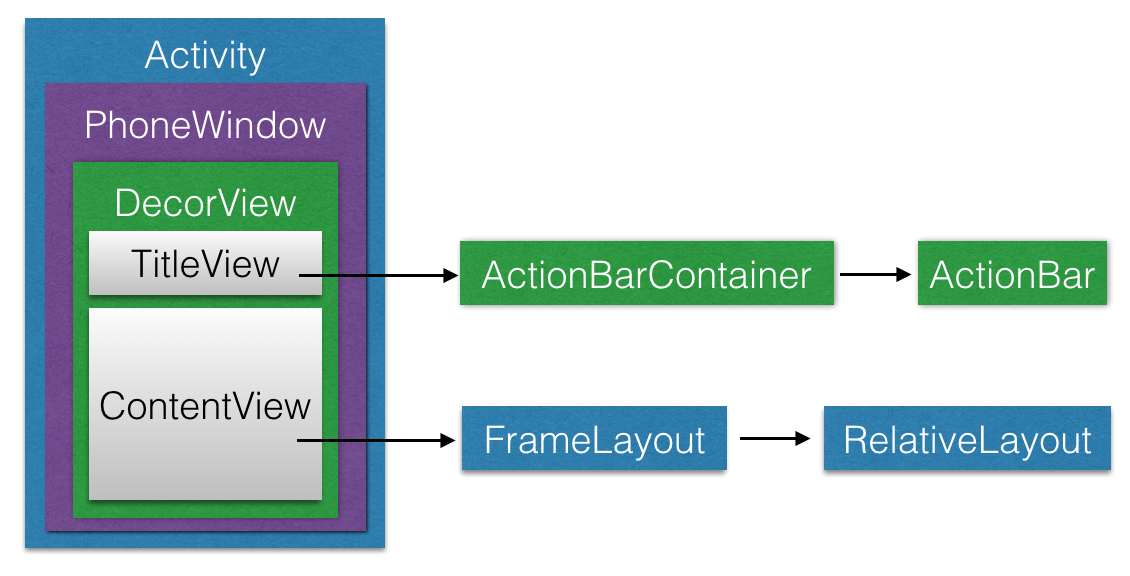概述
本篇文章会从源码(基于Android 6.0)角度分析Android中View的绘制流程,侧重于对整体流程的分析,对一些难以理解的点加以重点阐述,目的是把View绘制的整个流程把握好,而对于特定实现细节则可以日后再对相应源码进行研读。
在进行实际的分析之前,我们先来看下面这张图:
我们来对上图做出简单解释:DecorView是一个应用窗口的根容器,它本质上是一个FrameLayout。DecorView有唯一一个子View,它是一个垂直LinearLayout,包含两个子元素,一个是TitleView(ActionBar的容器),另一个是ContentView(窗口内容的容器)。关于ContentView,它是一个FrameLayout(android.R.id.content),我们平常用的setContentView就是设置它的子View。上图还表达了每个Activity都与一个Window(具体来说是PhoneWindow)相关联,用户界面则由Window所承载。
Window
Window即窗口,这个概念在Android Framework中的实现为android.view.Window这个抽象类,这个抽象类是对Android系统中的窗口的抽象。在介绍这个类之前,我们先来看看究竟什么是窗口呢?
实际上,窗口是一个宏观的思想,它是屏幕上用于绘制各种UI元素及响应用户输入事件的一个矩形区域。通常具备以下两个特点:
独立绘制,不与其它界面相互影响;
不会触发其它界面的输入事件;
在Android系统中,窗口是独占一个Surface实例的显示区域,每个窗口的Surface由WindowManagerService分配。我们可以把Surface看作一块画布,应用可以通过Canvas或OpenGL在其上面作画。画好之后,通过SurfaceFlinger将多块Surface按照特定的顺序(即Z-order)进行混合,而后输出到FrameBuffer中,这样用户界面就得以显示。
android.view.Window这个抽象类可以看做Android中对窗口这一宏观概念所做的约定,而PhoneWindow这个类是Framework为我们提供的Android窗口概念的具体实现。接下来我们先来介绍一下android.view.Window这个抽象类。
这个抽象类包含了三个核心组件:
WindowManager.LayoutParams: 窗口的布局参数;
Callback: 窗口的回调接口,通常由Activity实现;
ViewTree: 窗口所承载的控件树。
下面我们来看一下Android中Window的具体实现(也是唯一实现)——PhoneWindow。
PhoneWindow
前面我们提到了,PhoneWindow这个类是Framework为我们提供的Android窗口的具体实现。我们平时调用setContentView()方法设置Activity的用户界面时,实际上就完成了对所关联的PhoneWindow的ViewTree的设置。我们还可以通过Activity类的requestWindowFeature()方法来定制Activity关联PhoneWindow的外观,这个方法实际上做的是把我们所请求的窗口外观特性存储到了PhoneWindow的mFeatures成员中,在窗口绘制阶段生成外观模板时,会根据mFeatures的值绘制特定外观。
从setContentView()说开去
在分析setContentView()方法前,我们需要明确:这个方法只是完成了Activity的ContentView的创建,而并没有执行View的绘制流程。
当我们自定义Activity继承自android.app.Activity时候,调用的setContentView()方法是Activity类的,源码如下:
public void setContentView(@LayoutRes int layoutResID) {
getWindow().setContentView(layoutResID);
. . .
}getWindow()方法会返回Activity所关联的PhoneWindow,也就是说,实际上调用到了PhoneWindow的setContentView()方法,源码如下:
@Overridepublic void setContentView(int layoutResID) { if (mContentParent == null) { // mContentParent即为上面提到的ContentView的父容器,若为空则调用installDecor()生成
installDecor();
} else if (!hasFeature(FEATURE_CONTENT_TRANSITIONS)) { // 具有FEATURE_CONTENT_TRANSITIONS特性表示开启了Transition
// mContentParent不为null,则移除decorView的所有子View
mContentParent.removeAllViews();
} if (hasFeature(FEATURE_CONTENT_TRANSITIONS)) { // 开启了Transition,做相应的处理,我们不讨论这种情况
// 感兴趣的同学可以参考源码
. . .
} else { // 一般情况会来到这里,调用mLayoutInflater.inflate()方法来填充布局
// 填充布局也就是把我们设置的ContentView加入到mContentParent中
mLayoutInflater.inflate(layoutResID, mContentParent);
}
. . . // cb即为该Window所关联的Activity
final Callback cb = getCallback(); if (cb != null && !isDestroyed()) { // 调用onContentChanged()回调方法通知Activity窗口内容发生了改变
cb.onContentChanged();
}
. . .
}LayoutInflater.inflate()
在上面我们看到了,PhoneWindow的setContentView()方法中调用了LayoutInflater的inflate()方法来填充布局,这个方法的源码如下:
public View inflate(@LayoutRes int resource, @Nullable ViewGroup root) { return inflate(resource, root, root != null);
}public View inflate(@LayoutRes int resource, @Nullable ViewGroup root, boolean attachToRoot) { final Resources res = getContext().getResources();
. . . final XmlResourceParser parser = res.getLayout(resource); try { return inflate(parser, root, attachToRoot);
} finally {
parser.close();
}
}在PhoneWindow的setContentView()方法中传入了decorView作为LayoutInflater.inflate()的root参数,我们可以看到,通过层层调用,最终调用的是inflate(XmlPullParser, ViewGroup, boolean)方法来填充布局。这个方法的源码如下:
public View inflate(XmlPullParser parser, @Nullable ViewGroup root, boolean attachToRoot) { synchronized (mConstructorArgs) {
. . . final Context inflaterContext = mContext; final AttributeSet attrs = Xml.asAttributeSet(parser);
Context lastContext = (Context) mConstructorArgs[0];
mConstructorArgs[0] = inflaterContext;
View result = root; try { // Look for the root node.
int type; // 一直读取xml文件,直到遇到开始标记
while ((type = parser.next()) != XmlPullParser.START_TAG &&
type != XmlPullParser.END_DOCUMENT) { // Empty
} // 最先遇到的不是开始标记,报错
if (type != XmlPullParser.START_TAG) { throw new InflateException(parser.getPositionDescription()
+ ": No start tag found!");
} final String name = parser.getName();
. . . // 单独处理<merge>标签,不熟悉的同学请参考官方文档的说明
if (TAG_MERGE.equals(name)) { // 若包含<merge>标签,父容器(即root参数)不可为空且attachRoot须为true,否则报错
if (root == null || !attachToRoot) { throw new InflateException("<merge /> can be used only with a valid "+ "ViewGroup root and attachToRoot=true");
} // 递归地填充布局
rInflate(parser, root, inflaterContext, attrs, false);
} else { // temp为xml布局文件的根View
final View temp = createViewFromTag(root, name, inflaterContext, attrs);
ViewGroup.LayoutParams params = null; if (root != null) {
. . . // 获取父容器的布局参数(LayoutParams)
params = root.generateLayoutParams(attrs); if (!attachToRoot) { // 若attachToRoot参数为false,则我们只会将父容器的布局参数设置给根View
temp.setLayoutParams(params);
}
} // 递归加载根View的所有子View
rInflateChildren(parser, temp, attrs, true);
. . . if (root != null && attachToRoot) { // 若父容器不为空且attachToRoot为true,则将父容器作为根View的父View包裹上来
root.addView(temp, params);
} // 若root为空或是attachToRoot为false,则以根View作为返回值
if (root == null || !attachToRoot) {
result = temp;
}
}
} catch (XmlPullParserException e) {
. . .
} catch (Exception e) {
. . .
} finally {
. . .
} return result;
}
}在上面的源码中,首先对于布局文件中的<merge>标签进行单独处理,调用rInflate()方法来递归填充布局。这个方法的源码如下:
void rInflate(XmlPullParser parser, View parent, Context context,
AttributeSet attrs, boolean finishInflate) throws XmlPullParserException, IOException { // 获取当前标记的深度,根标记的深度为0
final int depth = parser.getDepth();
int type; while (((type = parser.next()) != XmlPullParser.END_TAG ||
parser.getDepth() > depth) && type != XmlPullParser.END_DOCUMENT) { // 不是开始标记则继续下一次迭代
if (type != XmlPullParser.START_TAG) { continue;
} final String name = parser.getName(); // 对一些特殊标记做单独处理
if (TAG_REQUEST_FOCUS.equals(name)) {
parseRequestFocus(parser, parent);
} else if (TAG_TAG.equals(name)) {
parseViewTag(parser, parent, attrs);
} else if (TAG_INCLUDE.equals(name)) { if (parser.getDepth() == 0) { throw new InflateException("<include /> cannot be the root element");
} // 对<include>做处理
parseInclude(parser, context, parent, attrs);
} else if (TAG_MERGE.equals(name)) { throw new InflateException("<merge /> must be the root element");
} else { // 对一般标记的处理
final View view = createViewFromTag(parent, name, context, attrs); final ViewGroup viewGroup = (ViewGroup) parent; final ViewGroup.LayoutParams params=viewGroup.generateLayoutParams(attrs); // 递归地加载子View
rInflateChildren(parser, view, attrs, true);
viewGroup.addView(view, params);
}
} if (finishInflate) { parent.onFinishInflate();
}
}我们可以看到,上面的inflate()和rInflate()方法中都调用了rInflateChildren()方法,这个方法的源码如下:
final void rInflateChildren(XmlPullParser parser, View parent, AttributeSet attrs, boolean finishInflate) throws XmlPullParserException, IOException {
rInflate(parser, parent, parent.getContext(), attrs, finishInflate);
}从源码中我们可以知道,rInflateChildren()方法实际上调用了rInflate()方法。
到这里,setContentView()的整体执行流程我们就分析完了,至此我们已经完成了Activity的ContentView的创建与设置工作。接下来,我们开始进入正题,分析View的绘制流程。
ViewRoot
在介绍View的绘制前,首先我们需要知道是谁负责执行View绘制的整个流程。实际上,View的绘制是由ViewRoot来负责的。每个应用程序窗口的decorView都有一个与之关联的ViewRoot对象,这种关联关系是由WindowManager来维护的。
那么decorView与ViewRoot的关联关系是在什么时候建立的呢?答案是Activity启动时,ActivityThread.handleResumeActivity()方法中建立了它们两者的关联关系。这里我们不具体分析它们建立关联的时机与方式,感兴趣的同学可以参考相关源码。下面我们直入主题,分析一下ViewRoot是如何完成View的绘制的。
View绘制的起点
当建立好了decorView与ViewRoot的关联后,ViewRoot类的requestLayout()方法会被调用,以完成应用程序用户界面的初次布局。实际被调用的是ViewRootImpl类的requestLayout()方法,这个方法的源码如下:
@Overridepublic void requestLayout() { if (!mHandlingLayoutInLayoutRequest) { // 检查发起布局请求的线程是否为主线程
checkThread();
mLayoutRequested = true;
scheduleTraversals();
}
}上面的方法中调用了scheduleTraversals()方法来调度一次完成的绘制流程,该方法会向主线程发送一个“遍历”消息,最终会导致ViewRootImpl的performTraversals()方法被调用。下面,我们以performTraversals()为起点,来分析View的整个绘制流程。
三个阶段
View的整个绘制流程可以分为以下三个阶段:
measure: 判断是否需要重新计算View的大小,需要的话则计算;
layout: 判断是否需要重新计算View的位置,需要的话则计算;
draw: 判断是否需要重新绘制View,需要的话则重绘制。
这三个子阶段可以用下图来描述:
measure阶段
此阶段的目的是计算出控件树中的各个控件要显示其内容的话,需要多大尺寸。起点是ViewRootImpl的measureHierarchy()方法,这个方法的源码如下:
private boolean measureHierarchy(final View host, final WindowManager.LayoutParams lp, final Resources res,
final int desiredWindowWidth, final int desiredWindowHeight) { // 传入的desiredWindowXxx为窗口尺寸
int childWidthMeasureSpec; int childHeightMeasureSpec; boolean windowSizeMayChange = false;
. . . boolean goodMeasure = false; if (!goodMeasure) {
childWidthMeasureSpec = getRootMeasureSpec(desiredWindowWidth, lp.width);
childHeightMeasureSpec = getRootMeasureSpec(desiredWindowHeight, lp.height);
performMeasure(childWidthMeasureSpec, childHeightMeasureSpec); if (mWidth != host.getMeasuredWidth() || mHeight != host.getMeasuredHeight()) {
windowSizeMayChange = true;
}
} return windowSizeMayChange;
}上面的代码中调用getRootMeasureSpec()方法来获取根MeasureSpec,这个根MeasureSpec代表了对decorView的宽高的约束信息。继续分析之前,我们先来简单地介绍下MeasureSpec的概念。
MeasureSpec是一个32位整数,由SpecMode和SpecSize两部分组成,其中,高2位为SpecMode,低30位为SpecSize。SpecMode为测量模式,SpecSize为相应测量模式下的测量尺寸。View(包括普通View和ViewGroup)的SpecMode由本View的LayoutParams结合父View的MeasureSpec生成。
SpecMode的取值可为以下三种:
EXACTLY: 对子View提出了一个确切的建议尺寸(SpecSize);
AT_MOST: 子View的大小不得超过SpecSize;
UNSPECIFIED: 对子View的尺寸不作限制,通常用于系统内部。
传入performMeasure()方法的MeasureSpec的SpecMode为EXACTLY,SpecSize为窗口尺寸。
performMeasure()方法的源码如下:
private void performMeasure(int childWidthMeasureSpec, int childHeightMeasureSpec) {
. . . try {
mView.measure(childWidthMeasureSpec, childHeightMeasureSpec);
} finally {
. . .
}
}上面代码中的mView即为decorView,也就是说会转向对View.measure()方法的调用,这个方法的源码如下:
/**
* 调用这个方法来算出一个View应该为多大。参数为父View对其宽高的约束信息。
* 实际的测量工作在onMeasure()方法中进行
*/public final void measure(int widthMeasureSpec, int heightMeasureSpec) {
. . .
// 判断是否需要重新布局
// 若mPrivateFlags中包含PFLAG_FORCE_LAYOUT标记,则强制重新布局
// 比如调用View.requestLayout()会在mPrivateFlags中加入此标记
final boolean forceLayout = (mPrivateFlags & PFLAG_FORCE_LAYOUT) == PFLAG_FORCE_LAYOUT; final boolean specChanged = widthMeasureSpec != mOldWidthMeasureSpec
|| heightMeasureSpec != mOldHeightMeasureSpec; final boolean isSpecExactly = MeasureSpec.getMode(widthMeasureSpec) == MeasureSpec.EXACTLY
&& MeasureSpec.getMode(heightMeasureSpec) == MeasureSpec.EXACTLY; final boolean matchesSpecSize = getMeasuredWidth() == MeasureSpec.getSize(widthMeasureSpec)
&& getMeasuredHeight() == MeasureSpec.getSize(heightMeasureSpec); final boolean needsLayout = specChanged
&& (sAlwaysRemeasureExactly || !isSpecExactly || !matchesSpecSize); // 需要重新布局
if (forceLayout || needsLayout) {
. . . // 先尝试从缓从中获取,若forceLayout为true或是缓存中不存在或是
// 忽略缓存,则调用onMeasure()重新进行测量工作
int cacheIndex = forceLayout ? -1 : mMeasureCache.indexOfKey(key); if (cacheIndex < 0 || sIgnoreMeasureCache) { // measure ourselves, this should set the measured dimension flag back
onMeasure(widthMeasureSpec, heightMeasureSpec);
. . .
} else { // 缓存命中,直接从缓存中取值即可,不必再测量
long value = mMeasureCache.valueAt(cacheIndex); // Casting a long to int drops the high 32 bits, no mask needed
setMeasuredDimensionRaw((int) (value >> 32), (int) value);
. . .
}
. . .
}
mOldWidthMeasureSpec = widthMeasureSpec;
mOldHeightMeasureSpec = heightMeasureSpec;
mMeasureCache.put(key, ((long) mMeasuredWidth) << 32 |
(long) mMeasuredHeight & 0xffffffffL); // suppress sign extension}从measure()方法的源码中我们可以知道,只有以下两种情况之一,才会进行实际的测量工作:
forceLayout为true:这表示强制重新布局,可以通过View.requestLayout()来实现;
needsLayout为true,这需要specChanged为true(表示本次传入的MeasureSpec与上次传入的不同),并且以下三个条件之一成立:
sAlwaysRemeasureExactly为true: 该变量默认为false;
isSpecExactly为false: 若父View对子View提出了精确的宽高约束,则该变量为true,否则为false
matchesSpecSize为false: 表示父View的宽高尺寸要求与上次测量的结果不同
对于decorView来说,实际执行测量工作的是FrameLayout的onMeasure()方法,该方法的源码如下:
@Overrideprotected void onMeasure(int widthMeasureSpec, int heightMeasureSpec) { int count = getChildCount();
. . . int maxHeight = 0; int maxWidth = 0; int childState = 0; for (int i = 0; i < count; i++) { final View child = getChildAt(i); if (mMeasureAllChildren || child.getVisibility() != GONE) {
measureChildWithMargins(child, widthMeasureSpec, 0, heightMeasureSpec, 0); final LayoutParams lp = (LayoutParams) child.getLayoutParams();
maxWidth = Math.max(maxWidth,
child.getMeasuredWidth() + lp.leftMargin + lp.rightMargin);
maxHeight = Math.max(maxHeight,
child.getMeasuredHeight() + lp.topMargin + lp.bottomMargin);
childState = combineMeasuredStates(childState, child.getMeasuredState());
. . .
}
} // Account for padding too
maxWidth += getPaddingLeftWithForeground() + getPaddingRightWithForeground();
maxHeight += getPaddingTopWithForeground() + getPaddingBottomWithForeground(); // Check against our minimum height and width
maxHeight = Math.max(maxHeight, getSuggestedMinimumHeight());
maxWidth = Math.max(maxWidth, getSuggestedMinimumWidth()); // Check against our foreground's minimum height and width
final Drawable drawable = getForeground(); if (drawable != null) {
maxHeight = Math.max(maxHeight, drawable.getMinimumHeight());
maxWidth = Math.max(maxWidth, drawable.getMinimumWidth());
}
setMeasuredDimension(resolveSizeAndState(maxWidth, widthMeasureSpec, childState),
resolveSizeAndState(maxHeight, heightMeasureSpec,
childState << MEASURED_HEIGHT_STATE_SHIFT));
. . .
}FrameLayout是ViewGroup的子类,后者有一个View[]类型的成员变量mChildren,代表了其子View集合。通过getChildAt(i)能获取指定索引处的子View,通过getChildCount()可以获得子View的总数。
在上面的源码中,首先调用measureChildWithMargins()方法对所有子View进行了一遍测量,并计算出所有子View的最大宽度和最大高度。而后将得到的最大高度和宽度加上padding,这里的padding包括了父View的padding和前景区域的padding。然后会检查是否设置了最小宽高,并与其比较,将两者中较大的设为最终的最大宽高。最后,若设置了前景图像,我们还要检查前景图像的最小宽高。
经过了以上一系列步骤后,我们就得到了maxHeight和maxWidth的最终值,表示当前容器View用这个尺寸就能够正常显示其所有子View(同时考虑了padding和margin)。而后我们需要调用resolveSizeAndState()方法来结合传来的MeasureSpec来获取最终的测量宽高,并保存到mMeasuredWidth与mMeasuredHeight成员变量中。
从以上代码的执行流程中,我们可以看到,容器View通过measureChildWithMargins()方法对所有子View进行测量后,才能得到自身的测量结果。也就是说,对于ViewGroup及其子类来说,要先完成子View的测量,再进行自身的测量(考虑进padding等)。
接下来我们来看下ViewGroup的measureChildWithMargins()方法的实现:
protected void measureChildWithMargins(View child, int parentWidthMeasureSpec, int widthUsed, int parentHeightMeasureSpec, int heightUsed) { final MarginLayoutParams lp = (MarginLayoutParams) child.getLayoutParams(); final int childWidthMeasureSpec = getChildMeasureSpec(parentWidthMeasureSpec,
mPaddingLeft + mPaddingRight + lp.leftMargin + lp.rightMargin + widthUsed, lp.width); final int childHeightMeasureSpec = getChildMeasureSpec(parentHeightMeasureSpec
mPaddingTop + mPaddingBottom + lp.topMargin + lp.bottomMargin + heightUsed, lp.height);
child.measure(childWidthMeasureSpec, childHeightMeasureSpec);
}由以上代码我们可以知道,对于ViewGroup来说,它会调用child.measure()来完成子View的测量。传入ViewGroup的MeasureSpec是它的父View用于约束其测量的,那么ViewGroup本身也需要生成一个childMeasureSpec来限制它的子View的测量工作。这个childMeasureSpec就由getChildMeasureSpec()方法生成。接下来我们来分析这个方法:
public static int getChildMeasureSpec(int spec, int padding, int childDimension) { // spec为父View的MeasureSpec
// padding为父View在相应方向的已用尺寸加上父View的padding和子View的margin
// childDimension为子View的LayoutParams的值
int specMode = MeasureSpec.getMode(spec); int specSize = MeasureSpec.getSize(spec); // 现在size的值为父View相应方向上的可用大小
int size = Math.max(0, specSize - padding); int resultSize = 0; int resultMode = 0; switch (specMode) { // Parent has imposed an exact size on us
case MeasureSpec.EXACTLY: if (childDimension >= 0) { // 表示子View的LayoutParams指定了具体大小值(xx dp)
resultSize = childDimension;
resultMode = MeasureSpec.EXACTLY;
} else if (childDimension == LayoutParams.MATCH_PARENT) { // 子View想和父View一样大
resultSize = size;
resultMode = MeasureSpec.EXACTLY;
} else if (childDimension == LayoutParams.WRAP_CONTENT) { // 子View想自己决定其尺寸,但不能比父View大
resultSize = size;
resultMode = MeasureSpec.AT_MOST;
} break; // Parent has imposed a maximum size on us
case MeasureSpec.AT_MOST: if (childDimension >= 0) { // 子View指定了具体大小
resultSize = childDimension;
resultMode = MeasureSpec.EXACTLY;
} else if (childDimension == LayoutParams.MATCH_PARENT) { // 子View想跟父View一样大,但是父View的大小未固定下来
// 所以指定约束子View不能比父View大
resultSize = size;
resultMode = MeasureSpec.AT_MOST;
} else if (childDimension == LayoutParams.WRAP_CONTENT) { // 子View想要自己决定尺寸,但不能比父View大
resultSize = size;
resultMode = MeasureSpec.AT_MOST;
} break;
. . .
} //noinspection ResourceType
return MeasureSpec.makeMeasureSpec(resultSize, resultMode);
}上面的方法展现了根据父View的MeasureSpec和子View的LayoutParams生成子View的MeasureSpec的过程, 子View的LayoutParams表示了子View的期待大小。这个产生的MeasureSpec用于指导子View自身的测量结果的确定。
在上面的代码中,我们可以看到当ParentMeasureSpec的SpecMode为EXACTLY时,表示父View对子View指定了确切的宽高限制。此时根据子View的LayoutParams的不同,分以下三种情况:
具体大小(childDimension):这种情况下令子View的SpecSize为childDimension,即子View在LayoutParams指定的具体大小值;令子View的SpecMode为EXACTLY,即这种情况下若该子View为容器View,它也有能力给其子View指定确切的宽高限制(子View只能在这个宽高范围内),若为普通View,它的最终测量大小就为childDimension。
match_parent:此时表示子View想和父View一样大。这种情况下得到的子View的SpecMode与上种情况相同,只不过SpecSize为size,即父View的剩余可用大小。
wrap_content: 这表示了子View想自己决定自己的尺寸(根据其内容的大小动态决定)。这种情况下子View的确切测量大小只能在其本身的onMeasure()方法中计算得出,父View此时无从知晓。所以暂时将子View的SpecSize设为size(父View的剩余大小);令子View的SpecMode为AT_MOST,表示了若子View为ViewGroup,它没有能力给其子View指定确切的宽高限制,毕竟它本身的测量宽高还悬而未定。
当ParentMeasureSpec的SpecMode为AT_MOST时,我们也可以根据子View的LayoutParams的不同来分三种情况讨论:
具体大小:这时令子View的SpecSize为childDimension,SpecMode为EXACTLY。
match_parent:表示子View想和父View一样大,故令子View的SpecSize为size,但是由于父View本身的测量宽高还无从确定,所以只是暂时令子View的测量结果为父View目前的可用大小。这时令子View的SpecMode为AT_MOST。
wrap_content:表示子View想自己决定大小(根据其内容动态确定)。然而这时父View还无法确定其自身的测量宽高,所以暂时令子View的SpecSize为size,SpecMode为AT_MOST。
从上面的分析我们可以得到一个通用的结论,当子View的测量结果能够确定时,子View的SpecMode就为EXACTLY;当子View的测量结果还不能确定(只是暂时设为某个值)时,子View的SpecMode为AT_MOST。
在measureChildWithMargins()方法中,获取了知道子View测量的MeasureSpec后,接下来就要调用child.measure()方法,并把获取到的childMeasureSpec传入。这时便又会调用onMeasure()方法,若此时的子View为ViewGroup的子类,便会调用相应容器类的onMeasure()方法,其他容器View的onMeasure()方法与FrameLayout的onMeasure()方法执行过程相似。
下面会我们回到FrameLayout的onMeasure()方法,当递归地执行完所有子View的测量工作后,会调用resolveSizeAndState()方法来根据之前的测量结果确定最终对FrameLayout的测量结果并存储起来。View类的resolveSizeAndState()方法的源码如下:
public static int resolveSizeAndState(int size, int measureSpec, int childMeasuredState) { final int specMode = MeasureSpec.getMode(measureSpec); final int specSize = MeasureSpec.getSize(measureSpec); final int result; switch (specMode) { case MeasureSpec.AT_MOST: if (specSize < size) { // 父View给定的最大尺寸小于完全显示内容所需尺寸
// 则在测量结果上加上MEASURED_STATE_TOO_SMALL
result = specSize | MEASURED_STATE_TOO_SMALL;
} else {
result = size;
} break; case MeasureSpec.EXACTLY: // 若specMode为EXACTLY,则不考虑size,result直接赋值为specSize
result = specSize; break; case MeasureSpec.UNSPECIFIED: default:
result = size;
} return result | (childMeasuredState & MEASURED_STATE_MASK);
}对于普通View,会调用View类的onMeasure()方法来进行实际的测量工作,该方法的源码如下:
protected void onMeasure(int widthMeasureSpec, int heightMeasureSpec) {
setMeasuredDimension(getDefaultSize(getSuggestedMinimumWidth(), widthMeasureSpec),
getDefaultSize(getSuggestedMinimumHeight(), heightMeasureSpec));
}对于普通View(非ViewgGroup)来说,只需完成自身的测量工作即可。以上代码中通过setMeasuredDimension()方法设置测量的结果,具体来说是以getDefaultSize()方法的返回值来作为测量结果。getDefaultSize()方法的源码如下:
public static int getDefaultSize(int size, int measureSpec) { int result = size; int specMode = MeasureSpec.getMode(measureSpec); int specSize = MeasureSpec.getSize(measureSpec); switch (specMode) { case MeasureSpec.UNSPECIFIED:
result = size; break; case MeasureSpec.AT_MOST: case MeasureSpec.EXACTLY:
result = specSize; break;
} return result;
}由以上代码我们可以看到,View的getDefaultSize()方法对于AT_MOST和EXACTLY这两种情况都返回了SpecSize作为result。所以若我们的自定义View直接继承了View类,我们就要自己对wrap_content (对应了AT_MOST)这种情况进行处理,否则对自定义View指定wrap_content就和match_parent效果一样了。
layout阶段
layout阶段的基本思想也是由根View开始,递归地完成整个控件树的布局(layout)工作。
View.layout()
我们把对decorView的layout()方法的调用作为布局整个控件树的起点,实际上调用的是View类的layout()方法,源码如下:
public void layout(int l, int t, int r, int b) { // l为本View左边缘与父View左边缘的距离
// t为本View上边缘与父View上边缘的距离
// r为本View右边缘与父View左边缘的距离
// b为本View下边缘与父View上边缘的距离
. . . boolean changed = isLayoutModeOptical(mParent) ? setOpticalFrame(l, t, r, b) : setFrame(l, t, r, b); if (changed || (mPrivateFlags & PFLAG_LAYOUT_REQUIRED) == PFLAG_LAYOUT_REQUIRED) {
onLayout(changed, l, t, r, b);
. . .
}
. . .
}这个方法会调用setFrame()方法来设置View的mLeft、mTop、mRight和mBottom四个参数,这四个参数描述了View相对其父View的位置(分别赋值为l, t, r, b),在setFrame()方法中会判断View的位置是否发生了改变,若发生了改变,则需要对子View进行重新布局,对子View的局部是通过onLayout()方法实现了。由于普通View( 非ViewGroup)不含子View,所以View类的onLayout()方法为空。因此接下来,我们看看ViewGroup类的onLayout()方法的实现。
ViewGroup.onLayout()
实际上ViewGroup类的onLayout()方法是abstract,这是因为不同的布局管理器有着不同的布局方式。
这里我们以decorView,也就是FrameLayout的onLayout()方法为例,分析ViewGroup的布局过程:
@Overrideprotected void onLayout(boolean changed, int left, int top, int right, int bottom) {
layoutChildren(left, top, right, bottom, false /* no force left gravity */);
}void layoutChildren(int left, int top, int right, int bottom, boolean forceLeftGravity) { final int count = getChildCount(); final int parentLeft = getPaddingLeftWithForeground(); final int parentRight = right - left - getPaddingRightWithForeground(); final int parentTop = getPaddingTopWithForeground(); final int parentBottom = bottom - top - getPaddingBottomWithForeground(); for (int i = 0; i < count; i++) { final View child = getChildAt(i); if (child.getVisibility() != GONE) { final LayoutParams lp = (LayoutParams) child.getLayoutParams(); final int width = child.getMeasuredWidth(); final int height = child.getMeasuredHeight(); int childLeft; int childTop; int gravity = lp.gravity; if (gravity == -1) {
gravity = DEFAULT_CHILD_GRAVITY;
} final int layoutDirection = getLayoutDirection(); final int absoluteGravity = Gravity.getAbsoluteGravity(gravity, layoutDirection); final int verticalGravity = gravity & Gravity.VERTICAL_GRAVITY_MASK; switch (absoluteGravity & Gravity.HORIZONTAL_GRAVITY_MASK) { case Gravity.CENTER_HORIZONTAL:
childLeft = parentLeft + (parentRight - parentLeft - width) / 2 +
lp.leftMargin - lp.rightMargin; break; case Gravity.RIGHT: if (!forceLeftGravity) {
childLeft = parentRight - width - lp.rightMargin; break;
} case Gravity.LEFT: default:
childLeft = parentLeft + lp.leftMargin;
} switch (verticalGravity) { case Gravity.TOP:
childTop = parentTop + lp.topMargin; break; case Gravity.CENTER_VERTICAL:
childTop = parentTop + (parentBottom - parentTop - height) / 2 +
lp.topMargin - lp.bottomMargin; break; case Gravity.BOTTOM:
childTop = parentBottom - height - lp.bottomMargin; break; default:
childTop = parentTop + lp.topMargin;
}
child.layout(childLeft, childTop, childLeft + width, childTop + height);
}
}
}在上面的方法中,parentLeft表示当前View为其子View显示区域指定的一个左边界,也就是子View显示区域的左边缘到父View的左边缘的距离,parentRight、parentTop、parentBottom的含义同理。确定了子View的显示区域后,接下来,用一个for循环来完成子View的布局。
在确保子View的可见性不为GONE的情况下才会对其进行布局。首先会获取子View的LayoutParams、layoutDirection等一系列参数。上面代码中的childLeft代表了最终子View的左边缘距父View左边缘的距离,childTop代表了子View的上边缘距父View的上边缘的距离。会根据子View的layout_gravity的取值对childLeft和childTop做出不同的调整。最后会调用child.layout()方法对子View的位置参数进行设置,这时便转到了View.layout()方法的调用,若子View是容器View,则会递归地对其子View进行布局。
到这里,layout阶段的大致流程我们就分析完了,这个阶段主要就是根据上一阶段得到的View的测量宽高来确定View的最终显示位置。显然,经过了measure阶段和layout阶段,我们已经确定好了View的大小和位置,那么接下来就可以开始绘制View了。
draw阶段
对于本阶段的分析,我们以decorView.draw()作为分析的起点,也就是View.draw()方法,它的源码如下:
public void draw(Canvas canvas) {
. . .
// 绘制背景,只有dirtyOpaque为false时才进行绘制,下同
int saveCount; if (!dirtyOpaque) {
drawBackground(canvas);
}
. . .
// 绘制自身内容
if (!dirtyOpaque) onDraw(canvas); // 绘制子View
dispatchDraw(canvas);
. . . // 绘制滚动条等
onDrawForeground(canvas);
}简单起见,在上面的代码中我们省略了实现滑动时渐变边框效果相关的逻辑。实际上,View类的onDraw()方法为空,因为每个View绘制自身的方式都不尽相同,对于decorView来说,由于它是容器View,所以它本身并没有什么要绘制的。dispatchDraw()方法用于绘制子View,显然普通View(非ViewGroup)并不能包含子View,所以View类中这个方法的实现为空。
ViewGroup类的dispatchDraw()方法中会依次调用drawChild()方法来绘制子View,drawChild()方法的源码如下:
protected boolean drawChild(Canvas canvas, View child, long drawingTime) { return child.draw(canvas, this, drawingTime);
}这个方法调用了View.draw(Canvas, ViewGroup,long)方法来对子View进行绘制。在draw(Canvas, ViewGroup, long)方法中,首先对canvas进行了一系列变换,以变换到将要被绘制的View的坐标系下。完成对canvas的变换后,便会调用View.draw(Canvas)方法进行实际的绘制工作,此时传入的canvas为经过变换的,在将被绘制View的坐标系下的canvas。
进入到View.draw(Canvas)方法后,会向之前介绍的一样,执行以下几步:
绘制背景;
通过onDraw()绘制自身内容;
通过dispatchDraw()绘制子View;
绘制滚动条
至此,整个View的绘制流程我们就分析完了。若文中有叙述不清晰或是不准确的地方,希望大家能够指出,谢谢大家: )
共同学习,写下你的评论
评论加载中...
作者其他优质文章







